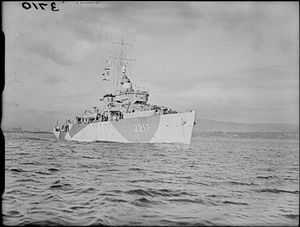HMS Loyalty (J217)
 | |
| Career (United Kingdom) | |
|---|---|
| Name: | HMS Loyalty |
| Builder: | Harland and Wolff, Belfast |
| Yard number: | 1142[1] |
| Laid down: | 14 April 1941 |
| Launched: | 9 December 1942 |
| Completed: | 22 April 1943[1] |
| Commissioned: | 22 April 1943 |
| Renamed: |
Launched as HMS Rattler Renamed HMS Loyalty in June 1943 |
| Motto: | "Fight for the King" |
| Honours and awards: | Normandy 1944 |
| Fate: | Sunk on 22 August 1944 by U-480 |
| Badge: | On a Field barry wavy of six White and Blue, a sprig of three oak leaves, Gold |
| General characteristics | |
| Class and type: | Algerine-class minesweeper |
| Displacement: | 850 tons |
| Length: | 225 ft (69 m) |
| Beam: | 35 ft 6 in (10.82 m) |
| Propulsion: | Geared turbines two shafts 2,000 ihp |
| Complement: | 85 men |
| Armament: |
|
| Notes: | Pennant number J217 |
HMS Loyalty was an Algerine-class minesweeper of the Royal Navy. She served during the Second World War.
Service
Loyalty was laid down as HMS Rattler on 14 April 1941 at Harland and Wolff, Belfast, and launched on 9 December 1942. She was commissioned on 22 April 1943, and renamed HMS Loyalty in June 1943. She was adopted by the community of Ripley, North Yorkshire after a Warship Week national savings campaign in March 1942.
After commissioning she was assigned to the 18th Minesweeping Flotilla, joining them in June 1943. She and the other ships of the flotilla carried out sweeping operations in Lyme Bay and the English Channel. She and other ships of the flotilla were transferred to Harwich in August to sweep areas of the North Sea, but was soon transferred to the 9th Flotilla, at Dover. On 25 August Loyalty was part of Operation Starkey, an attempt to attract German aircraft to unusual minesweeping operations near the French coast. The ships of the flotilla came under fire from shore batteries, and HMS Hydra was damaged. They returned to Dover, but were mistakenly fired on by British shore batteries, causing further damage. Loyalty did not return to minesweeping duties until October.
In November Loyalty transferred to Scapa Flow to join the 15th Minesweeping Flotilla with the Home Fleet. She transferred again in December to the Orkney and Shetland Command, operating out of Seidisfjord on anti-submarine patrols and local convoy escort duties. She remained here until being nominated to return to the UK in March 1944 and in April underwent a refit at Portsmouth, after which she was assigned to Force G to give minesweeping support to the allied landings in Normandy. Loyalty spent May carrying out exercises and rehearsals, and also escorted HMS Stormcloud into Portsmouth after she had been damaged by a mine. Loyalty then took part in the assault operations of 6 June, clearing Channel 6, and then remaining deployed off Gold Beach to cover operations. She remained off Normandy after the landings and throughout July, carrying out sweeps of the anchorages.
Sinking
Loyalty was still off Normandy in August. She was returning to Portsmouth with the minesweepers HMS Ready, Hound, Hydra and Rattlesnake when the sweep wires parted. Loyalty and the minesweeping trawler Doon were dispatched to recover the sweep. As they were doing this Loyalty was attacked and sunk by the German U-boat U-480 commanded by Hans-Joachim Förster at position 50°09′N 00°41′W / 50.150°N 0.683°WCoordinates: 50°09′N 00°41′W / 50.150°N 0.683°W in the English Channel. She capsized in less than seven minutes, with the loss of her captain and 18 ratings. There were 30 survivors. Loyalty was replaced in the flotilla by HMS Tanganyika. The wrecksite is designated as a protected place under the Protection of Military Remains Act 1986.
References
- Colledge, J. J.; Warlow, Ben (2006) [1969]. Ships of the Royal Navy: The Complete Record of all Fighting Ships of the Royal Navy (Rev. ed.). London: Chatham Publishing. ISBN 978-1-86176-281-8. OCLC 67375475.
External links
- HMS Loyalty's wartime career
- MoD announcement of designation
- SI 2008/950 Designation under Protection of Military Remains Act
| ||||||||||||||||||||||||||||